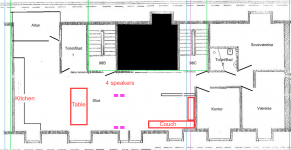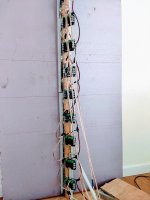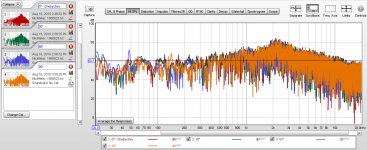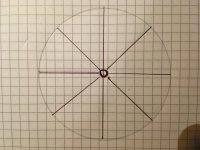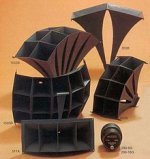So, just when I thought I was ready for a prototype of the “perfect speaker!”, Bateman pointed me towards another thread regarding people’s preference for wide dispersion speakers. My planned design weren’t wide dispersion, direct radiator style.
My question now. What would an omnidirectional constant directivity point source look like? A synergy type horn shaped like the Duevel speakers? I can’t wrap my head around it. So any thoughts on the subject would be interesting to read. Also if people got any design ideas?
My question now. What would an omnidirectional constant directivity point source look like? A synergy type horn shaped like the Duevel speakers? I can’t wrap my head around it. So any thoughts on the subject would be interesting to read. Also if people got any design ideas?
I've asked that myself too, but have not found a good solution. Many options have a non-constant vertical dispersion. For example, a cone driver pointing at the ceiling must be smaller than a dome tweeter to be truly omnidirectional. Horns have a limited vertical dispersion so they are not truly omnidirectional, though a limited but constant vertical dispersion might be acceptable as well.
Mr. Floyd Toole mentions in his book Sound Reproduction* that reflections from the front wall (the wall behind the speakers) should be absorbed, for which he refers to research that shows that this improves image localization and reduces coloration. That suggests that in-wall speakers with only hemispherical radiation, mounted in this particular wall, are better than true omnipole sources. I think Hemispherical radiation would be easier to achieve as well.
[*] p. 116 in Ch. 8: Imaging and Spatial Effects in Sound Reproduction
Mr. Floyd Toole mentions in his book Sound Reproduction* that reflections from the front wall (the wall behind the speakers) should be absorbed, for which he refers to research that shows that this improves image localization and reduces coloration. That suggests that in-wall speakers with only hemispherical radiation, mounted in this particular wall, are better than true omnipole sources. I think Hemispherical radiation would be easier to achieve as well.
[*] p. 116 in Ch. 8: Imaging and Spatial Effects in Sound Reproduction
Last edited:
TBTL pretty much covered it.
Shoot for a low diffraction enclosure for best results.
Comparison of 'Xbush Sphere synergy horn', versus 'Balls of Prestige'.
Shoot for a low diffraction enclosure for best results.
Comparison of 'Xbush Sphere synergy horn', versus 'Balls of Prestige'.
Actually it is mission impossible. But for speech frequencies used in acoustical measurements of buildings, these are used FP122 - Omni-directional Sound Source - CESVA instruments

For hifi, Duevel has some nice solutions Bella Luna high end loudspeaker

For hifi, Duevel has some nice solutions Bella Luna high end loudspeaker
An externally hosted image should be here but it was not working when we last tested it.
Last edited:
I've asked that myself too, but have not found a good solution. Many options have a non-constant vertical dispersion. For example, a cone driver pointing at the ceiling must be smaller than a dome tweeter to be truly omnidirectional. Horns have a limited vertical dispersion so they are not truly omnidirectional, though a limited but constant vertical dispersion might be acceptable as well.
Mr. Floyd Toole mentions in his book Sound Reproduction* that reflections from the front wall (the wall behind the speakers) should be absorbed, for which he refers to research that shows that this improves image localization and reduces coloration. That suggests that in-wall speakers with only hemispherical radiation, mounted in this particular wall, are better than true omnipole sources. I think Hemispherical radiation would be easier to achieve as well.
[*] p. 116 in Ch. 8: Imaging and Spatial Effects in Sound Reproduction
In-wall will not work for me. I have a fairly long living space of 55 m2. In one end is the couch-area and in the other end is the dining table and kitchen.
I need speakers placed halfway between the dining table and couch area. Ideally 4 speakers back to back. 2 pointing towards the dining table and 2 pointing towards the couch.
This is why omni would be ideal or figure eight.
Any experience with speakers back to back?
If Duevel type speakers could be made like synergy-horns and work like actual waveguides. As I see it, the Duevel waveguide is just a diffuser of some sort. It seems to be what one should avoid because of early reflections and diffraction.
The Duevel posted is omni, it doesn't sound like you want omni? A plan of your room and where you want the speakers would help.In-wall will not work for me. I have a fairly long living space of 55 m2. In one end is the couch-area and in the other end is the dining table and kitchen.
I need speakers placed halfway between the dining table and couch area. Ideally 4 speakers back to back. 2 pointing towards the dining table and 2 pointing towards the couch.
This is why omni would be ideal or figure eight.
The Duevel posted is omni, it doesn't sound like you want omni? A plan of your room and where you want the speakers would help.
Attachments
I live on the top floor with an angled ceiling. The "teeth" in the perimeter of the drawing are windows.
I notice you have two bad toilets in your floor plan. Always prioritize plumbing repairs over speakers. I should know because I postponed repairing a freezer that was leaking all over the floor every defrost cycle so I could build some experimental speakers. Finally, a friend came over and forced me to repair the freezer.
I'll explain my thinking. I combined a CBT array with a distributed mode loudspeaker array that becomes pistonic at lower frequencies. My goal was to have wide physical dispersion with narrow psychoacoustic perception. It also provided something I didn't know I wanted, a vertical sound field.
It measures and sounds the same front and rear. But it isn't omni. It's dipole. It cancels on the sides. It's narrow and thin. On the other hand, it's tall. It also requires a minimum of six channels of DSP to delay curve the CBT portion of the array. And DSP is absolutely required for EQ. I'm sure a genius can figure out how to design the panel materials and dampening without EQ, but I certainly can't.
Or maybe not. I'm not sure because I don't know if the CBT is helping or not. REW measurements read a chaotic frequency response at the mic that I can smooth, but I don't know what really going on. I think I hear improvement with the CBT but I can't trust my ears and inherent bias. It's possible that a multi-actuator array in a narrow-tall without CBT time delay and shading sounds just as good.
Subjectively, they do what I wanted even though I can't figure out how to properly measure them with REW. They also do something I didn't know I wanted, produce a vertical sound field. To my untrained ear, strings and piano sounds great. I think it's because of the vertical sound field of a tall array but I don't know.
The bottom line is that with your floor plan you might like a tall-narrow dipole CBT built with traditional cone speakers. If you use DSP you can make it a straight array rather than a physically curved array. You'd be able to accurately measure CBT performance with REW because you'd have regular cone speakers. And most of your EQ would be handled with good driver selection. You'd get dipole cancellation on the sides but I'm not sure if you'd notice it because your sitting/standing areas are in the kitchen and on the couch. People standing in the kitchen would get good sound and so would people sitting on the couch. Most people wouldn't notice the sound was degraded for a moment when they walked from the kitchen to the couch.
I'll explain my thinking. I combined a CBT array with a distributed mode loudspeaker array that becomes pistonic at lower frequencies. My goal was to have wide physical dispersion with narrow psychoacoustic perception. It also provided something I didn't know I wanted, a vertical sound field.
It measures and sounds the same front and rear. But it isn't omni. It's dipole. It cancels on the sides. It's narrow and thin. On the other hand, it's tall. It also requires a minimum of six channels of DSP to delay curve the CBT portion of the array. And DSP is absolutely required for EQ. I'm sure a genius can figure out how to design the panel materials and dampening without EQ, but I certainly can't.
Or maybe not. I'm not sure because I don't know if the CBT is helping or not. REW measurements read a chaotic frequency response at the mic that I can smooth, but I don't know what really going on. I think I hear improvement with the CBT but I can't trust my ears and inherent bias. It's possible that a multi-actuator array in a narrow-tall without CBT time delay and shading sounds just as good.
Subjectively, they do what I wanted even though I can't figure out how to properly measure them with REW. They also do something I didn't know I wanted, produce a vertical sound field. To my untrained ear, strings and piano sounds great. I think it's because of the vertical sound field of a tall array but I don't know.
The bottom line is that with your floor plan you might like a tall-narrow dipole CBT built with traditional cone speakers. If you use DSP you can make it a straight array rather than a physically curved array. You'd be able to accurately measure CBT performance with REW because you'd have regular cone speakers. And most of your EQ would be handled with good driver selection. You'd get dipole cancellation on the sides but I'm not sure if you'd notice it because your sitting/standing areas are in the kitchen and on the couch. People standing in the kitchen would get good sound and so would people sitting on the couch. Most people wouldn't notice the sound was degraded for a moment when they walked from the kitchen to the couch.
Attachments
Are there any measurement plots of those type Dueval speakers? I remember looking for measurements on them some years back, never found anything.
I notice you have two bad toilets in your floor plan. Always prioritize plumbing repairs over speakers. I should know because I postponed repairing a freezer that was leaking all over the floor every defrost cycle so I could build some experimental speakers. Finally, a friend came over and forced me to repair the freezer.
I'll explain my thinking. I combined a CBT array with a distributed mode loudspeaker array that becomes pistonic at lower frequencies. My goal was to have wide physical dispersion with narrow psychoacoustic perception. It also provided something I didn't know I wanted, a vertical sound field.
It measures and sounds the same front and rear. But it isn't omni. It's dipole. It cancels on the sides. It's narrow and thin. On the other hand, it's tall. It also requires a minimum of six channels of DSP to delay curve the CBT portion of the array. And DSP is absolutely required for EQ. I'm sure a genius can figure out how to design the panel materials and dampening without EQ, but I certainly can't.
Or maybe not. I'm not sure because I don't know if the CBT is helping or not. REW measurements read a chaotic frequency response at the mic that I can smooth, but I don't know what really going on. I think I hear improvement with the CBT but I can't trust my ears and inherent bias. It's possible that a multi-actuator array in a narrow-tall without CBT time delay and shading sounds just as good.
Subjectively, they do what I wanted even though I can't figure out how to properly measure them with REW. They also do something I didn't know I wanted, produce a vertical sound field. To my untrained ear, strings and piano sounds great. I think it's because of the vertical sound field of a tall array but I don't know.
The bottom line is that with your floor plan you might like a tall-narrow dipole CBT built with traditional cone speakers. If you use DSP you can make it a straight array rather than a physically curved array. You'd be able to accurately measure CBT performance with REW because you'd have regular cone speakers. And most of your EQ would be handled with good driver selection. You'd get dipole cancellation on the sides but I'm not sure if you'd notice it because your sitting/standing areas are in the kitchen and on the couch. People standing in the kitchen would get good sound and so would people sitting on the couch. Most people wouldn't notice the sound was degraded for a moment when they walked from the kitchen to the couch.
LOL! "Bad" means bath/shower in Danish :-D
Regarding linearrays and other tall speakers. One side of the room (closest to the windows) is not tall enough because of the angled ceiling. So it's not an option, unfortunately.
We have some clone threads here
Transmission line Omni speakers? Duevel Planets clone with transmission line?
My new project: Duevel Omni design
OmniDirectional - work in progress
Google helps to find some measurements and more clones
Transmission line Omni speakers? Duevel Planets clone with transmission line?
My new project: Duevel Omni design
OmniDirectional - work in progress
Google helps to find some measurements and more clones
Last edited:
The Duevel looks intuitively like a good solution but I believe it to be flawed. If diffraction is bad, then the Duevels should suck. It's not a true waveguide but a sound-difractor. The sound from the woofer will hit the diffractor at different angles and at different distances. It must create phase and lobing issues.
Has somebody tried to build a 360 degree multi cell horn consisting of conical flares with a compression driver at the center of the horns both in the top and bottom?
Attachments
One side of the room (closest to the windows) is not tall enough because of the angled ceiling.
Probably a pretty room like I see in movies where Tom Cruise leaps from one European roof to the next, loses his footing, and stares face to face with a surprised and immediately infatuated girl looking out the window of a top floor flat while he briefly considers how to adapt to his current predicament.
If I had to quickly figure out how to adapt to your room I might consider the cardinal sin of using a mono array in the high side of the room. Then I'd swing my body weight and attempt a controlled fall into a passing garbage truck that softened my escape from certain death.
- Status
- Not open for further replies.
- Home
- Loudspeakers
- Multi-Way
- Wide dispersion/omnidirectional pointsource
